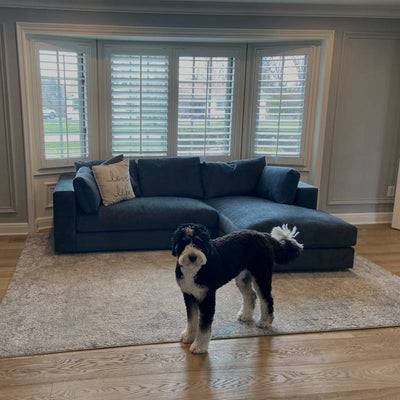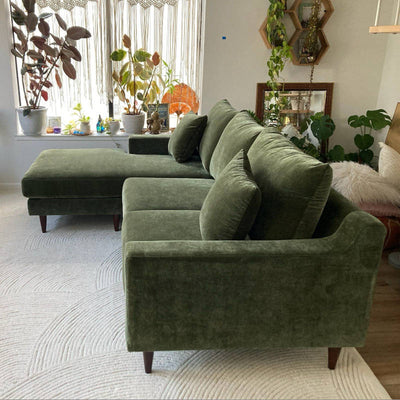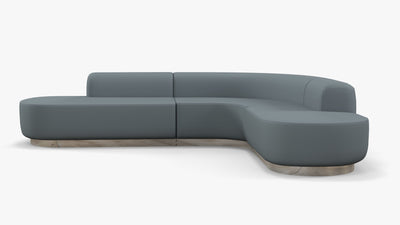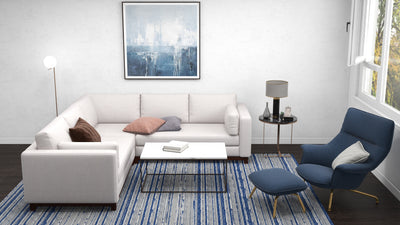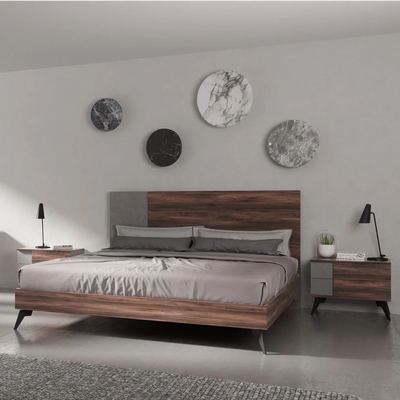A few decades ago most couches and sofas built in the U.S. were made in small shops with 50 or fewer employees. Products were primarily built one piece at a time by a single highly skilled upholsterer working on an entire piece.
Today, most upholstered furniture found in large U.S. chain retailers is mass-produced in enormous factories. In these settings, production of vast quantities of identical items is most efficiently managed in cells, where lower-skilled (and lower-paid) workers are assigned to build a small part of each couch repeatedly. For instance, a manufacturing cell in a large factory might include one worker upholstering only the outside arms, another working on the inside arms, another on the outside backs, and another on the inside backs. The designs must be straightforward so that fabric covers can be pre-sewn and easily “socked on” over each part of the sofa. This setup allows each component to be upholstered quickly by workers with minimal skills.
Thirty years ago, the top 25 furniture retailers controlled less than 10% of U.S. nationwide furniture sales, with annual sales of under $50 million qualifying a retailer for this group. Today, the top 25 retailers account for 80% of nationwide furniture purchases, with the smallest among them generating $675 million in annual sales.
Modern mass-produced sofas are typically assembled with some variations in the following steps:
- Frame Construction: The frame, made from plywood, composite wood products, or inexpensive solid wood (such as rubberwood in Asia and pine in Europe), is assembled using various joinery techniques along with staples, screws, and other hardware.
- Support Surface: A flexible support surface is required for the seating and back areas. Commonly used materials include special composite elastic fabric bands, which are stapled evenly to the frame using a nail gun due to their low cost. Alternatively, S-shaped (also known as sinuous wire or zigzag) springs can be used.
- Protective Layer: The basic structure may be covered with a layer of non-woven protective fabric.
- Padding and Cushions: The frame is then covered with padding and cushions. The specific methods and materials for this step vary depending on the sofa's style and shape.
This process enables the efficient mass production of sofas while accommodating variations in design and materials.
Frame Construction:
- Cost-effective Method: Pre-formed shapes from polyurethane foam are cut and combined to create different looks, glued together as needed to form the basic shapes.
- Covering: Pre-cut and sewn fabric covers are applied to the sofa, secured with glue, stitches, or staples to fit the frame and upholstery.
- Cushions: Made separately, cushions can offer significant cost savings when produced in large quantities. The least expensive foam that lasts through the warranty period is often used. Cushions have a foam or spring core, typically wrapped in Dacron fiber. Sometimes, a fabric ticking is used over the foam and beneath the fabric cover. Pneumatic machinery stuffs cushion inserts through tiny zippers, reducing manual labor from minutes to seconds.
- Leg Attachment: Legs are fitted, usually screwed into the base, though some styles have built-in legs or a wood/metal support frame.
- Final Touches: A sheet of non-woven textile is stapled to the bottom of the sofa to protect it from dust.
How Are Higher-End Sofas Made:
Higher-end couches use more expensive materials and require greater workmanship and skill, but the basic technique remains the same.
Frame Materials:
- Variety: Frames can be made from various materials, each with different qualities. For instance, 7-ply 1” plywood is stronger than 0.5” plywood with three plies.
- Engineered Hardwood: Includes medium-density fiberboard (MDF), particle board, and inexpensive plywood for lower-cost frames.
- Thickness: Generally, the thicker the wood or wood product, the stronger the frame. High-end solid wood frames are typically 5/4” thick, while less expensive frames are 4/4” or less.
- Wood Species: Maple, favored for high-end frames, is durable and easy to work with. Harder woods like oak or hickory are durable but harder to work with, while softer woods like poplar, birch, or pine are easier to work with but less strong. High-end furniture rarely uses these softer woods in 5/4” thicknesses.
- Lumber Quality: #1 grade or Select lumber has fewer knotholes, splits, and imperfections than #2 grade lumber.
- Kiln-drying: Important to prevent warping over time, as green (undried) lumber can lead to frame failure due to widened cracks, knotholes, and imperfections.
Identifying Wood Quality:
Lift one end of the sofa. Higher quality frames are heavier, with 5/4” solid wood frames being particularly heavy. Frame joints, after lumber imperfections, are typically the weakest part of the frame.
Different types of sofa frame joints include:
Different types of sofa frame joints include various methods, each with its own strengths and applications. Mortise and tenon is the strongest method, used when two pieces of wood meet at a 90-degree angle. In this method, one piece of wood has a hole (mortise), and the other is cut to fit precisely into that hole (tenon), creating a robust and durable joint.
Another method is the double dowel, where small wooden cylinders called dowels are inserted into round holes drilled into two pieces of wood to hold them together. As the name suggests, double dowel joints use two dowels at each joint. While not as sturdy as mortise and tenon joints and more likely to loosen over time, double dowel joints are still a perfectly acceptable method found in many upholstery frames.
Corners are typically weak points on wood furniture and often need reinforcement. This is achieved through corner block reinforcement, where an extra piece of wood, usually triangular, is placed at an angle and secured with glue, staples, or screws. Reinforced joinery generally describes adding an extra layer of support to keep joints in place, using various combinations of glue, screws, or staples.
There are many other ways of joining furniture. Some methods, such as dovetail and box joints, are highly effective and commonly used in building cabinetry and wood furniture. However, there are also less effective methods, such as butt joints, where two pieces of wood are joined with only glue, screws, or a combination of the two. Metal connectors attached to two pieces of wood are another example of less sturdy joinery methods.
Sofa Spring Systems
The 8-way hand-tied spring is a mark of quality and has been considered the "gold standard" for over a century. These foundations were invented when cushion materials like horsehair, down/feathers, and cotton were commonly used. These materials are non-resilient, meaning they can compress all the way down to the sofa deck. In such cases, the 8-way hand-tied coil provides the best foundation support available.
Today's high-density foam cushions, however, are much more resilient and significantly thicker than the older cushions made with non-resilient materials. As a result, you do not sink all the way to the deck, and you don't feel the foundation underneath. Therefore, the hundreds of dollars extra that 8-way hand-tied coils cost are mostly wasted since they are not noticeable when you sit.
Drawbacks of 8 way hand tied coils (aside from cost) include:
- They do not last any longer than many far less expensive foundation options.
- Many modern styles are built lower to the ground and do not have enough space underneath to accommodate the 8 way coils.
- Many companies now use drop-in coil systems which resemble 8 way hand tied, but are far less costly to make and do not provide the same level of comfort. It is very difficult for a non-expert to distinguish between these drop-in units and the real thing.
Sofa Frame Coil Spring
Sinuous wire, also known as zig-zag springs, are S-shaped and simpler in construction, making them very inexpensive. These springs are attached to the frame with clips and usually last just as long, or even longer, than the far more expensive 8-way hand-tied coil foundation.
Webbing is another alternative for sofa support, which can vary in quality. The effectiveness of webbing depends on its quality, width, the number of strips used, and the strength of the frame. Webbing comes in different widths and is stretched across the deck (or frame) and woven back and forth like reed strips in a basket. Higher-priced sofas with webbing foundations typically have more strips and smaller gaps than less expensive couches. Jute webbing, found in older sofas, is less durable and flexible compared to newer elasticized webbing materials. Elasticized webbing can also be used to support the back frame, providing improved durability and flexibility.
The High Quality Sofa Cushions
Cushion construction is the single most important factor in determining the lifespan and comfort of your sofa, couch, or chair.
On low and mid-priced furniture, the cushions are almost always the first part to wear out and need replacement. In higher-cost sofas, fabrics, particularly natural fibers like cotton or linen, may wear out sooner. Most cushions sold on low and mid-priced upholstered furniture will begin to lose their shape and comfort within 1-3 years and will need replacement within 3-5 years. For most mass-produced sofas, cushion replacement is not a realistic option, as replacement cushions are rarely available from the retailer where the furniture was purchased, and custom replacement cushions can be expensive.
There are three basic types of cushion construction for most couches and sofas sold in the U.S.: foam, coil springs, and down/feathers. Many cushions are made using a combination of two or all three of these constructions.
Foam is the most commonly sold cushion construction, available in several different densities, each with a wide variety of firmnesses. Although most people think that density and firmness are synonymous, they are actually very different. Foam suppliers typically stock 4-5 commonly used densities for residential furniture seat cushions, ranging from 1.5 to 2.5. The number designates the weight (in pounds) of one cubic foot of foam. Each of these different densities may be available in 10 or more different firmnesses, ranging from very soft to very firm. The expected lifespan of a foam cushion is primarily dependent on the density and thickness of the foam. Another important factor is whether the foam is HR (High Resiliency), which recovers its shape better after use. The frequency of use and the size of the people using the cushion will also affect a seat cushion’s lifespan. A foam cushion’s firmness has very little effect on the expected lifespan. However, since most consumers equate firmness with durability, cheap foams are often made extra firm. With low-density foam, that extra firm feeling will not last long.
Foams used in seat cushions for moderately priced residential furniture generally range from 1.5 through 2.0. Lower-density foams are typically used for back cushions or padding that goes over the arms or other parts of the frame. Higher densities (2.0 – 2.5) can be found on more expensive residential furniture. Furniture designed for heavy commercial or institutional use may use foam with densities of 3.0 or higher. The higher the foam density, the more the cushion will cost. Variations in firmness usually do not affect cost. HR (High Resilience) foam is more expensive than non-HR foams.
The most commonly used foam density for residential furniture sold in the U.S. is 1.8. Foam that is described as high density without any specific number is usually 1.8 density foam. Foam cores are usually 4″ – 6″ thick and are typically wrapped in dacron polyester fiber. Fiber wrapping is generally 0.5 – 1.5″ thick on the top and bottom of the cushion. It softens the feel of the cushion and will add 2-3″ to the total cushion thickness but has no effect on lifespan.
Four-inch thick foam cores made with 1.8 density HR (High Resiliency) foam can be expected to last about two years with average use before the foam begins to lose its ability to bounce back and keep its shape. Five-inch thick foam cores made with 1.8 density HR foam can be expected to last about three years with average use before the foam begins to lose its ability to bounce back and keep its shape. Foam cushions will typically still be usable for another couple of years after the deterioration process begins. Foams that are not High Resiliency will deteriorate more rapidly.
Actual foam densities will vary during the manufacturing process. A variation of 0.1 is considered normal. A 1.8 density foam may actually be 1.7 or 1.9. Larger variations are not unusual. Many couches are sold with cheaper (and lighter weight) 1.5 density foam that will deteriorate even more rapidly, sometimes within one year of purchase. The overall thickness of a cushion may or may not be an indication of its durability. Value-priced couches will sometimes have cushions bulked up with several inches of polyester fiber around the foam core. That polyester fiber will rapidly compress, causing the cushion to lose its shape. Better quality sofas typically use 1″ – 1.5″ of fiber on each side of the cushion. Lower quality couches may use up to 3″ of fiber on each side. Thick layers of fiber are a cheap way to bulk up a cushion over the short term, but thick fiber quickly compresses and causes the cushion to lose its shape, often within one year.
If you want to get more than five years of use from your couch, you will need to find a couch with a better quality cushion. Higher-priced couches generally use thicker, higher density foams with at least a 2.0 density, but preferably higher. Cushions supported by built-in coil springs are typically, but not always, more durable than lower density foam cushions. These coil springs are surrounded by a foam border (typically 1.5 or 1.8 density) and then padded on the top and bottom with additional soft padding.
What's in the Sofa Cushion:
The Quality of Sofa Fabrics:
There are thousands of fabrics available, with hundreds more introduced each month. Fabric prices can vary widely, with wholesale prices for manufacturers ranging from $2 per yard to over $100 per yard. Typically, using a $50 per yard fabric can increase the retail price of an average-sized sofa by approximately $600 to $800 compared to a $5 per yard fabric.
Many consumers do not realize that even high-end manufacturers often offer fabrics purchased in the $5 to $10 per yard range, in addition to more expensive options. Natural fibers like cotton, linen, and wool are generally less durable and harder to clean than synthetic fabrics. Synthetics, such as 100% polyester and 100% olefin, are extremely popular due to their durability, ease of cleaning, and low cost. Blends of synthetic and natural fibers can be more expensive while still retaining durability and cleanability.
Fiber types also affect durability. Natural fibers, like cotton, take color differently from man-made fibers, offering richer and more subtle hues, while synthetics provide resilience and strength. Blends combine the properties of both natural and synthetic fibers. For example, a cotton and polyester blend can offer the best attributes of both materials. Other common blends include nylon, acrylic, rayon, wool, and silk.
Technological advancements in man-made fibers over the past decade have allowed 100% polyester to imitate the look and feel of materials like cotton, linen, suede, velvet, wool, and silk. Fabric durability also depends on the weight and weave of the fibers, measured in threads per inch. For example, a heavy woven cotton tapestry, where colors and patterns are tightly woven with colored threads, wears better than cotton with printed colors. To check a fabric's quality, hold it up to the light; the less light that shows through, the tighter the weave.
High-performance fabrics, which combine heavy-duty durability with stainproof technology, have become increasingly popular. Brands like Crypton, Sunbrella, and Revolution dominate this market. Most high-performance fabrics are made in the U.S., revitalizing the American textile industry, which had declined as mills moved to China in the 1990s.
Certain textures can change with use. Fabrics with a nap, like velvets and corduroys, look different in various lights and show wear in frequently used areas. Silks are delicate, but many are fortified with man-made fibers. Textured surfaces, like loopy tweeds and homespuns, can develop pulls over time. Fabric can completely transform a couch & l shaped sectional's look, changing it from traditional to modern and blending into or accenting a room. Fabric choice is a significant expression of personal taste and style.
Leather differs significantly from fabric in both material properties and manufacturing requirements. Leather ranges from expensive to extremely expensive. Made from animal hides, leather comes in irregular shapes and sizes, leading to high waste percentages when cutting due to holes, brands, insect bites, and other flaws.
Leather manufacturing processes, including cutting, sewing, and upholstering, take much longer than fabric. Specialized sewing equipment and greater skill and experience are needed, making mistakes costly. There are hundreds of different types of leather, with prices varying dramatically.
The least expensive leathers are "protected" leathers, cheaper hides with many flaws that are heavily dyed and processed, removing the natural grain and then synthetically restoring it. The most expensive leathers are natural leathers, which have no processing or protective coating and show all natural flaws. Expensive computerized cutting machinery can significantly reduce waste.















